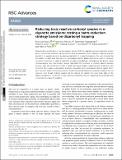Reducing toxic reactive carbonyl species in e-cigarette emissions : testing a harm-reduction strategy based on dicarbonyl trapping
Abstract
Reducing the concentration of reactive carbonyl species (RCS) in e-cigarette emissions represents a major goal to control their potentially harmful effects. Here, we adopted a novel strategy of trapping carbonyls present in e-cigarette emissions by adding polyphenols in e-liquid formulations. Our work showed that the addition of gallic acid, hydroxytyrosol and epigallocatechin gallate reduced the levels of carbonyls formed in the aerosols of vaped e-cigarettes, including formaldehyde, methylglyoxal and glyoxal. Liquid chromatography mass spectrometry analysis highlighted the formation of covalent adducts between aromatic rings and dicarbonyls in both e-liquids and vaped samples, suggesting that dicarbonyls were formed in the e-liquids as degradation products of propylene glycol and glycerol before vaping. Short-term cytotoxic analysis on two lung cellular models showed that dicarbonyl-polyphenol adducts are not cytotoxic, even though carbonyl trapping did not improve cell viability. Our work sheds lights on the ability of polyphenols to trap RCS in high carbonyl e-cigarette emissions, suggesting their potential value in commercial e-liquid formulations.
Citation
de Falco , B , Petridis , A , Paramasivan , P , Troise , A D , Scaloni , A , Deeni , Y , Stephens , W E & Fiore , A 2020 , ' Reducing toxic reactive carbonyl species in e-cigarette emissions : testing a harm-reduction strategy based on dicarbonyl trapping ' , RSC Advances , vol. 10 , no. 36 , pp. 21535-21544 . https://doi.org/10.1039/D0RA02138E
Publication
RSC Advances
Status
Peer reviewed
ISSN
2046-2069Type
Journal article
Description
The Carnegie Trust for the Universities of Scotland is thanked for providing funding to support this research (Grant Reference 50408).Collections
Items in the St Andrews Research Repository are protected by copyright, with all rights reserved, unless otherwise indicated.

